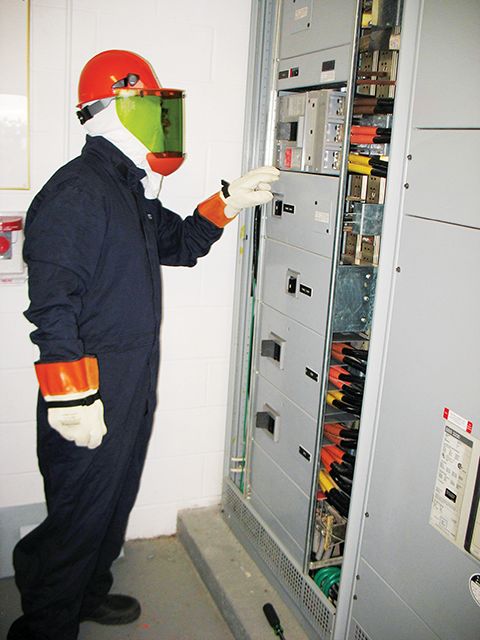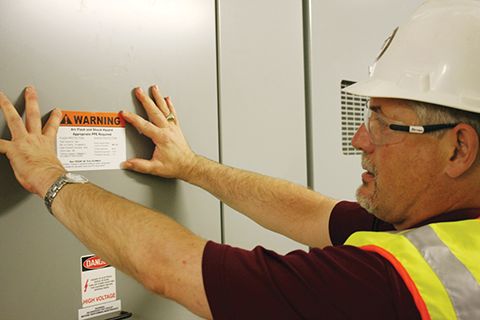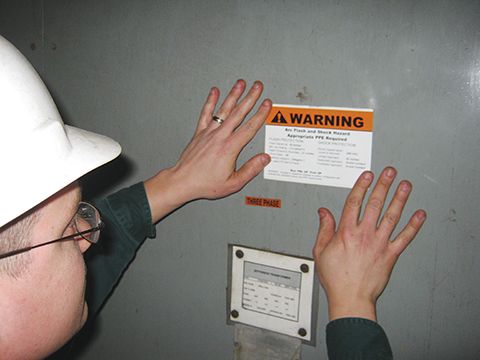Too Hot to Handle: All about arc flash protection
by Katie Daniel | October 28, 2015 10:37 am
 [1]
[1]by Stephen Devon, PE, CxA, LEED AP
In the Academy Award-winning movie, portrays Matthew McConaughey as an electrician injured by being exposed to an arc flash—a type of electrical explosion produced by a combination of extreme heat, intense bright light, and a pressure wave.
While this example is from a Hollywood blockbuster, it is not dissimilar to reality. Data from the U.S. Bureau of Labor Statistics shows more than 2000 workers sustain non-fatal electrical injuries every year. Those involved in maintaining facilities have a difficult task—when it comes to the electrical system, injuries can happen if procedures are followed incorrectly or if unqualified personnel are interacting with the system. Consequently, the National Electrical Code (NEC) now requires all distribution equipment, including panelboard, switchboard, and motor disconnects, to have arc flash labels if it is to be interacted with while energized. This NEC requirement means building owners can be held liable if anyone is harmed while handling the equipment, or if equipment is incorrectly labeled.
Those involved in designing and building should have a basic understanding of what is involved in preparing arc flash labels so they can specify and qualify the product, and prepare solicitations for owners of both new and existing buildings. Although the final product is a simple ‘peel-and-stick’ label, the information on each is critical and needs to be accurate.
Installing arc flash labels can be relatively easy, but what differentiates labels is the information printed on each, along with the support functions required to achieve NEC objectives. Specifiers need to have a basic understanding of what is involved in preparing these labels to make sure they receive an end product that is accurate and includes all the services necessary to comply with the code.
Preparing an arc flash study
Whether the building is new or existing, a complete power distribution diagram must be created. If the building is new, the engineer should provide the required information. If it is an existing building, the engineer and/or contractor will need to survey the entire facility to obtain feeder sizes and lengths, equipment manufacturers, and sizes of equipment and transformers. They will then use a technical software package to calculate each piece of equipment’s various energy levels based on a category rating from 0 to 4—with ‘Category 0’ being the least severe rating and ‘Category 4’ being the most severe. In some cases, field adjustments can be made to the equipment on completion of the arc flash study to mitigate the magnitude of the energy levels and lower the category rating.
The alternative to preparing calculations is to use the tables in the 2015 edition of National Fire Protection Agency (NFPA) 70E, Standard for Electrical Safety in the Workplace. The qualifiers noted with the values in the tables often negate their applicability, and performing calculations ensures more accuracy of the final data.
Label all equipment
The results from the arc flash study will serve as the foundation for all safety procedures implemented moving forward—including the labeling of all electrical equipment. Since 2002, Article 110.16 of the National Electrical Code required all electrical distribution equipment be properly field labeled in order to warn personnel of potential electric arc flash hazards.
Based on the amount of incident energy that could be developed by a piece of equipment, measured in calories per square centimeter, labels are to be provided which indicate the arc flash boundary, nominal system voltage, and incident energy level, along with the required level of personal protective equipment (PPE).
 [2]
[2]The PPE required to interface with each piece of equipment is based on that equipment’s category level. Therefore, labeling all equipment by category is key to promoting a safe work environment.
For example, if the amount of energy is between 1.2 and 4 cal/cm2, it is considered ‘Category 1.’ When working on ‘Category 1’ equipment, personnel are required to wear an arc-rated long-sleeve shirt and pants (synthetic material is unacceptable), a helmet, eye protection, and leather gloves. ‘Category 4’ equipment, on the other hand, allows up to 40 cal/cm2 and requires much more cumbersome and expensive PPE, including heavier arc-rated clothing, overalls, a hood, gloves, a hard hat, a face shield, and ear protection. Anything over 40 cal/cm2 is considered ‘dangerous,’ and must be labeled as such, and should not be interacted with while energized regardless of available PPE.
If equipment is not labeled, building personnel will be unaware of the level of equipment they are dealing with, and therefore be ill-prepared to do their jobs safely.
 [3]
[3]Provide proper training
In addition to preparing the study and labeling all equipment, there is a third, critical piece to administrating the electrical system—training.
Personnel need to be thoroughly educated on how to safely use all electrical equipment. Simply labeling everything is not enough if staff members do not know what the labels mean or how those labels should inform the electrical maintenance process.
Most electrical work performed in buildings should be performed on de-energized equipment, but that is not always possible in facilities related to healthcare, research, or industry, or any building where managing interaction with electrical equipment is not rigidly controlled. Even when working on de-energized equipment, personnel must remove the equipment cover first, which can put the user in danger until he or she has confirmed the panel board is indeed de-energized. It is imperative personnel are trained to properly remove equipment covers and test the system.
Personnel also need to be trained to understand when they should not touch equipment. For example, many buildings obtain their electrical power from secondary services supplied by local power companies. Arc flash studies indicate incoming switchboards served by transformers 500KVA or larger, and especially those with a 208-volt incoming service, will most likely be labeled as ‘dangerous.’ In those cases, an outage by the power company is required before any work can be done on the switchboard—even for something as simple as resetting the breaker.
At a minimum, all personnel should learn how to interpret each label, identify the proper PPE to wear in various scenarios, safely de-energize equipment, and navigate the best practices of typical electrical work.
While equipment labeling may seem nonessential, it is worth the effort in the long run as it can prevent serious injury and save lives. Should a worker be injured on the job due to improperly labeled electrical equipment, the building owner could be found at fault and be required to compensate the worker. Some injured workers have received millions of dollars because of facility negligence. Additionally, the Occupational Safety & Health Administration (OSHA) has fined companies tens of thousands of dollars for not having the appropriate procedures in place for workers who interact with electrical equipment on a regular basis.1
Costs
Arc flash labeling can be accomplished by a small increase in cost on new construction and can be a specified requirement as part of the contract documents. On existing buildings, the cost to prepare an arc flash study depends on the size and age of the building, and on good documentation. Bundling as many existing buildings as possible into one contract is a great way to make the process more cost effective. It is important to remember when working with or counseling building owners who need to prioritize costs, the cost of not bringing an electrical system into code compliance and experiencing a hazardous incident is much greater than the expense to actually take these precautionary measures.
All three steps—the arc flash study, equipment labeling, and training—along with properly maintaining the system on an ongoing basis, will minimize the likelihood of a hazardous event and a lawsuit against the building owner.
There is an array of services available when preparing a specification or proposal for solicitation of an arc flash study. This author has seen a facility where every panelboard was labeled ‘dangerous,’ which protected the owner but made maintaining the system much more cumbersome. This is because each piece of equipment had to be de-energized, meaning portions of the building were without power, when a ‘Category 1’ labeling and PPE would possibly have sufficed.
When soliciting for an arc flash study, the proposal should:
- be prepared by a licensed engineer with experience in similar studies (and references);
- utilize a recognized software system such as SKM, Easy Power, or ETAP;
- be comprehensive, from service entrance equipment to disconnects on motors;
- include remedial adjustments of existing equipment to obtain the lowest PPE category possible without impacting system reliability on existing systems;
- provide equipment layout recommendations in order to take advantage of a device’s incident energy reduction capability for new systems in the design phase;
- give special consideration to arc-flash reduction techniques in areas where system interaction will be necessary;
- include a complete single line diagram of the electrical system for posting at the service-entrance of equipment; and
- perform to meet the requirements of compliance with NFPA 70E, consistent with Institute of Electrical and Electronics Engineers (IEEE) 1584.1-2013, Guide for the Specification of Scope and Deliverable Requirements for Arc-flash Hazard Calculation Study.
As with all specification writing, the more detailed the requirements, (i.e. clear, concise, correct, and complete) the better the quality of the product.
Stephen Devon is an electrical engineer with more than 30 years of experience in program planning, feasibility studies, and project management of multi-discipline projects and associated staff. He remains informed of the latest technologies of not only his discipline, but also of others to ensure the right approaches and systems are being implemented. Devon works to bring together the in-house disciplines and other consultants and takes into consideration construction issues to ensure a successful project. He can be reached at steve.devon@rmf.com[4].
- [Image]: http://www.constructionspecifier.com/wp-content/uploads/2015/10/arc_ArcFlash1.jpg
- [Image]: http://www.constructionspecifier.com/wp-content/uploads/2015/10/arc_Labeling2.jpg
- [Image]: http://www.constructionspecifier.com/wp-content/uploads/2015/10/arc_Labeling3.jpg
- steve.devon@rmf.com: mailto:steve.devon@rmf.com
Source URL: https://www.constructionspecifier.com/too-hot-to-handle-all-about-arc-flash-protection/